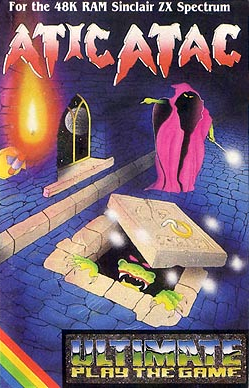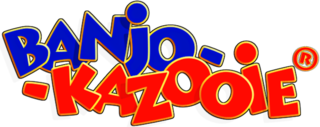Ashby Computers and Graphics Limited, trading as Ultimate Play the Game, was a British video game developer and publisher, founded in 1982, by ex-arcade video game developers Tim and Chris Stamper. Ultimate released a series of successful games for the ZX Spectrum, Amstrad CPC, BBC Micro, MSX and Commodore 64 computers from 1983 until 1987. Ultimate are perhaps best remembered for the big-selling titles Jetpac and Sabre Wulf, each of which sold over 300,000 copies in 1983 and 1984 respectively, and their groundbreaking series of isometric arcade adventures using a technique termed Filmation. Knight Lore, the first of the Filmation games, has been retrospectively described in the press as "seminal ... revolutionary" (GamesTM), "one of the most successful and influential games of all time" (X360), and "probably ... the greatest single advance in the history of computer games" (Edge).

Rare Limited is a British video game developer and a studio of Xbox Game Studios based in Twycross, Leicestershire. Rare's games span the platform, first-person shooter, action-adventure, fighting, and racing genres. Its most popular games include the Battletoads, Donkey Kong, and Banjo-Kazooie series, as well as games like GoldenEye 007 (1997), Perfect Dark (2000), Conker's Bad Fur Day (2001), Viva Piñata (2006), and Sea of Thieves (2018).

Sabre Wulf is an action-adventure game released by British video game developer Ultimate Play the Game for the ZX Spectrum home computer in 1984. The player navigates the pith-helmeted Sabreman through a 2D jungle maze while collecting amulet pieces to bypass the guardian at its exit. The player does not receive explicit guidance on how to play and is left to decipher the game's objectives through trial and error. Sabreman moves between the maze's 256 connected screens by touching the border where one screen ends and another begins. Each screen is filled with colourful flora, enemies that spawn at random, and occasional collectibles.

Jetpac is a shooter video game developed and published by Ultimate Play the Game and released for the ZX Spectrum and VIC-20 in 1983 and the BBC Micro in 1984. It is the first game to be released by Ultimate Play the Game, the company which later became Rare. The game follows Jetman as he must rebuild his rocket in order to explore different planets, while simultaneously defending against hostile aliens. It was written by Ultimate co-founder Chris Stamper with graphics designed by his brother, Tim Stamper. Reviewers praised Jetpac's presentation and gameplay, and it won "Game of the Year" at the Golden Joystick Awards in 1983.

Knight Lore is a 1984 action-adventure game developed and published by Ultimate Play the Game, and written by company founders Chris and Tim Stamper. The game is known for its use of isometric graphics, which it further popularized in video games. In Knight Lore, the player character Sabreman has forty days to collect objects throughout a castle and brew a cure to his werewolf curse. Each castle room is depicted in monochrome on its own screen and consists of blocks to climb, obstacles to avoid, and puzzles to solve.

Diddy Kong Racing is a 1997 kart racing game developed and published by Rare for the Nintendo 64. The game revolves around Diddy Kong and his friends' attempt to defeat the intergalactic antagonist, a wizard pig named Wizpig, through winning a series of races. The player takes control of any of the featured characters throughout the game. Diddy Kong Racing features five worlds with four racetracks each, and the ability to drive a car, hovercraft, or pilot an aeroplane.

Underwurlde is a 1984 action-adventure platform video game in the Sabreman series by Ultimate Play the Game for the ZX Spectrum and Commodore 64. The player controls the adventurer Sabreman as he jumps between platforms in a castle and its caverns to find an escape past the exit guardians. Underwurlde features about 600 flip screen areas. Unlike other games of its time, Sabreman is not injured when touched by enemies and is instead knocked backwards. Underwurlde is the second game in the series, between Sabre Wulf and Knight Lore, and released shortly before the latter for the ZX Spectrum in late 1984. Another developer, Firebird, ported the game to the Commodore 64 the next year.

It's Mr. Pants is a puzzle video game developed by Rare and published by THQ for the Game Boy Advance. It was released in North America in 2004 and Europe in 2005. A port of the game for mobile phones was developed and published internationally by In-Fusio in 2005–2006. The game stars Mr. Pants, a crudely drawn mascot formerly featured on Rare's website who had made cameo appearances in several prior Rare games.

Pentagram is a ZX Spectrum and MSX video game released by Ultimate Play the Game in 1986. It is the fourth in the Sabreman series, following on from his adventures in Sabre Wulf, Underwurlde and Knight Lore. Similarly to Knight Lore it uses the isometric Filmation engine. The game was written by either Tim and Chris Stamper or a U.S. Gold programming team.

Atic Atac is an arcade-adventure video game developed and published by Ultimate Play the Game, released for the ZX Spectrum in 1983 and the BBC Micro in 1985. The game takes place within a castle in which the player must seek out the "Golden Key of ACG" by unlocking doors and avoiding enemies. It was Ultimate's second game to require 48K of RAM; most of their previous games for the Spectrum ran on unexpanded 16K models.
Mire Mare is an unreleased video game by Ultimate Play the Game.

Banjo-Kazooie is a platform game series developed by Rare, a British company. The games feature a male bear named Banjo and his friend, a large female red bird named Kazooie, both of whom are controlled by the player. Banjo originally made his debut as a playable character in 1997 as part of the cast of Diddy Kong Racing. Throughout the various games, they are tasked with thwarting the various evil schemes of a witch named Gruntilda. The first game, Banjo-Kazooie, was released in 1998 to critical acclaim and was followed by three sequels and a spin-off racing game.

Filmation is the name of the isometric graphics engine employed in a series of games developed by Ultimate Play the Game during the 1980s, primarily on the 8-bit ZX Spectrum platform, though various titles also appeared on the BBC Micro, Amstrad CPC, MSX and Commodore 64 platforms.
Gregg Mayles is a British video game designer currently working for video game company Rare as creative director. He is one of the longest-serving members of the company, having worked there since 1989.

Banjo-Pilot is a 2005 kart racing video game for the Game Boy Advance (GBA) and the fourth installment in Rare's Banjo-Kazooie series. It plays similarly to the Mario Kart series by Nintendo: the player races one of nine playable characters around tracks, attacking other racers with bullets and collecting power-ups. The game features a number of single-player and multiplayer modes, such as time attack and item hunts. Unlike other kart racing games, characters control airplanes instead of go-karts.

Rare Replay is a 2015 compilation of 30 video games from the 30-year history of developers Rare and its predecessor, Ultimate Play the Game. The emulated games span multiple genres and consoles—from the ZX Spectrum to the Xbox 360—and retain the features and errors of their original releases with minimal edits. The compilation adds cheats to make the older games easier and a Snapshots mode of specific challenges culled from parts of the games. Player progress is rewarded with behind-the-scenes footage and interviews about Rare's major and unreleased games.

Sabre Wulf is a 2004 video game by Rare for the Game Boy Advance. The player controls the safari adventurer Sabreman, who runs and jumps between platforms to retrieve treasure guarded by the Sabre Wulf. The game is a remake of the 1984 action-adventure Sabre Wulf. Though the remake's reviews were generally favourable, sales were lackluster. Reviewers noted the game's simplicity and shallow puzzles. While some found it fun and praised its character animations, reviewers considered its gameplay repetitive.

Brothers Tim and Chris Stamper are British entrepreneurs who founded the video game companies Ultimate Play the Game and Rare. They first worked together on arcade conversion kits, which were licensed to companies, but later became developers for the ZX Spectrum home computer in the early 1980s. Chris programmed the games, while Tim designed the graphics. They found success as Ultimate with games including Jetpac and Knight Lore. After reverse engineering the Nintendo Entertainment System and deciding to shift their focus to console development, the brothers founded Rare in the mid-1980s. They became Nintendo's first major Western developer, for whom they developed licensed games and ports. Over the next two decades, Rare enjoyed a close relationship with Nintendo and developed multiple major titles for the company, including Donkey Kong Country and GoldenEye 007. Microsoft acquired Rare in 2002, and the brothers left the company in 2007. After spending several years out of the public eye, the brothers are currently planning new ventures.














